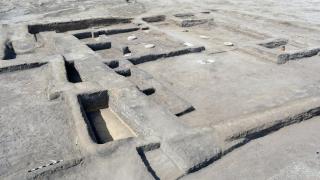An Egyptian archaeological mission led by the famous and controversial Zahi Hawass has discovered a series of intact parts of the foundation wall of the Valley Temple of Queen Hatshepsutin the Deir el Bahari complex of Luxor, and the tomb of an important official of the last dynasty of the Middle Kingdom of the Ancient Egyptfrom 4,000 years ago. The excavations have documented over several campaigns more than a thousand decorated stone blocks in the surroundings of the complex, as announced by archaeologists this Wednesday at a press conference.
Zawass, former Minister of Antiquities of the Nile country, has detailed the discovery of “a large number of inscriptions in the Valley Temple, which They are very rare and beautiful“There are very few similar examples in other Egyptian museums,” he added. This collection dates back to the reigns of Hatshepsut, one of the few women who ruled the civilization of the pharaohs – she did so approximately between 1473 and 1458 BC -, and her successor Thutmose III (died 1425 BC).
The Egyptologist has stated that the thousand documented blocks are full of “the most beautiful scenes I have seen in my life with that color”: “It is the first time that we have a final program of the decoration of a temple dating back to the 18th Dynasty.” Mohamed Ismail Khaled, secretary general of the Supreme Council of Antiquities, added that these pieces offer relevant information about the art of the period. In addition, they have been discovered a hundred limestone tablets. One of them retained the name of Senmut, the architect responsible for the construction of Hatshepsut’s temple, located near the Valley of the Kings.
Wooden coffins inside the tomb of Djehuty Mes.
Reuters
The work, led by the Heritage Foundation run by Hawass and which has had the collaboration of the Egyptian Government, has documented the simple tomb of Djehuty Messupervisor of the palace of Queen Tetisheri, grandmother of the pharaoh who freed Egypt from the yoke of the Hyksos peoples. The tomb was dug into the rock and was located at the end of a domed adobe chapel with drawings on the walls painted in red on a layer of white mortar.
“Despite the high status of the owner, the relative modesty of the tomb reflects the economic challenges that Egypt faced at that time due to the prolonged wars against the Hyksos,” Hawass said. The archaeologist has also suggested that this discovery indicates that Queen Tetisheri remained alive until the ninth year of Ahmose’s reign and that the burial site of Kamose, the last pharaoh of the 17th Dynasty, may be nearby.
Light on the golden age
The popular Egyptologist, honoring his bombastic assessments, has described this discovery as the most significant to be made in Luxor on the west bank of the Nile since the discovery of Tutankhamun’s tomb, marking a milestone in the study of the history of Ancient Egypt.
Researchers have also brought to light other funerary wells carved into the rock that contained wooden coffins with human appearanceknown as “feather coffins”, very characteristic of the time. Among them, that of a small child buried about 3,600 years ago stands out.

Finally, we have identified the vestiges of older necropolises buried by the temple of Hatshepsut in which fragments of ceramics, offerings or bread molds have appeared; and another later cemetery, from the Ptolemaic period (305-30 BC), this time located on the remains of the pharaoh’s funerary complex. Objects dated to this time include bronze coins with depictions of Alexander the Greatchildren’s toys and masks and funeral beetles.
The mission’s findings ultimately help to enrich knowledge of the transition from the Middle Kingdom to the 18th Dynasty, the golden age of Ancient Egypt, as well as the impact of the Hyksos invasion. Additionally, they offer new data on funeral practicesthe artistic achievements and enduring importance of Queen Hatshepsut’s temple as a cultural and historical landmark.

